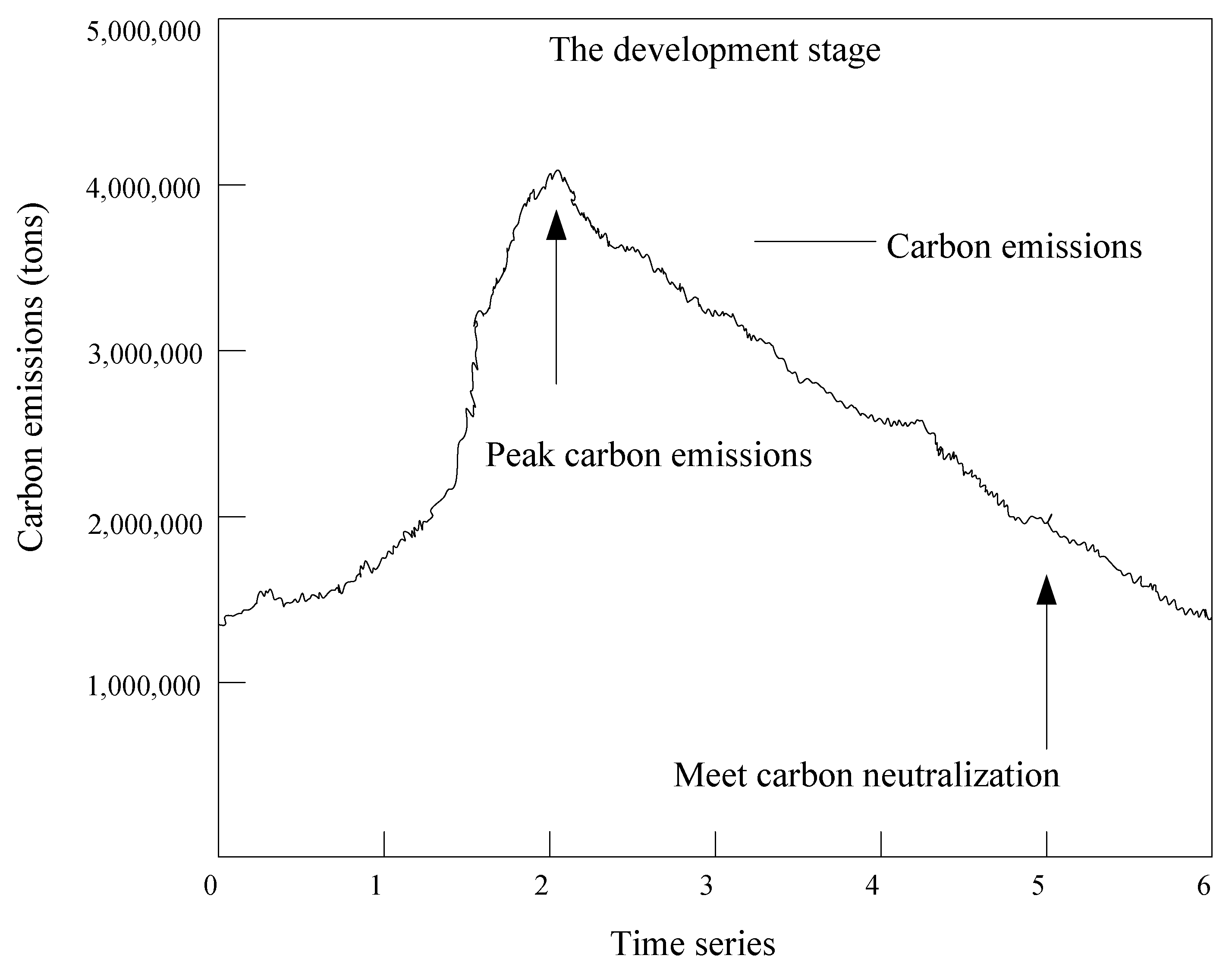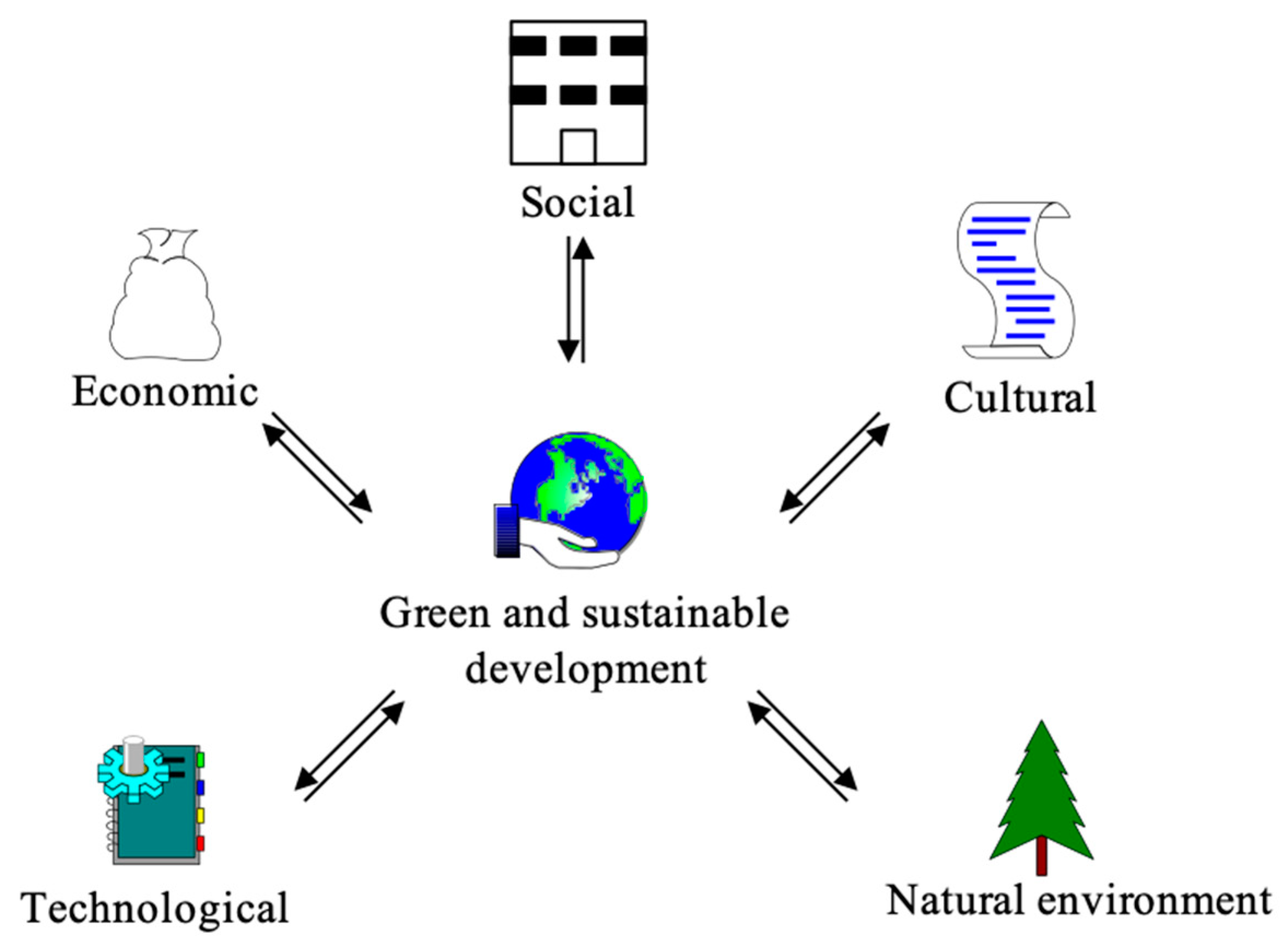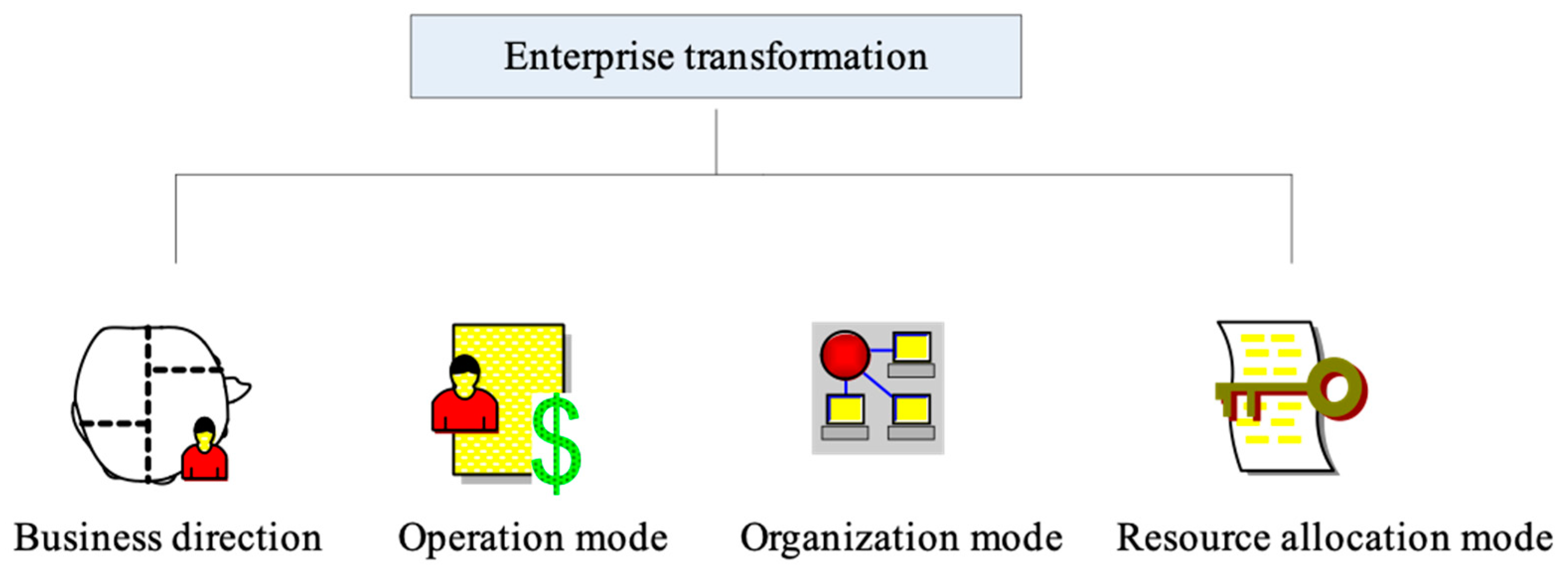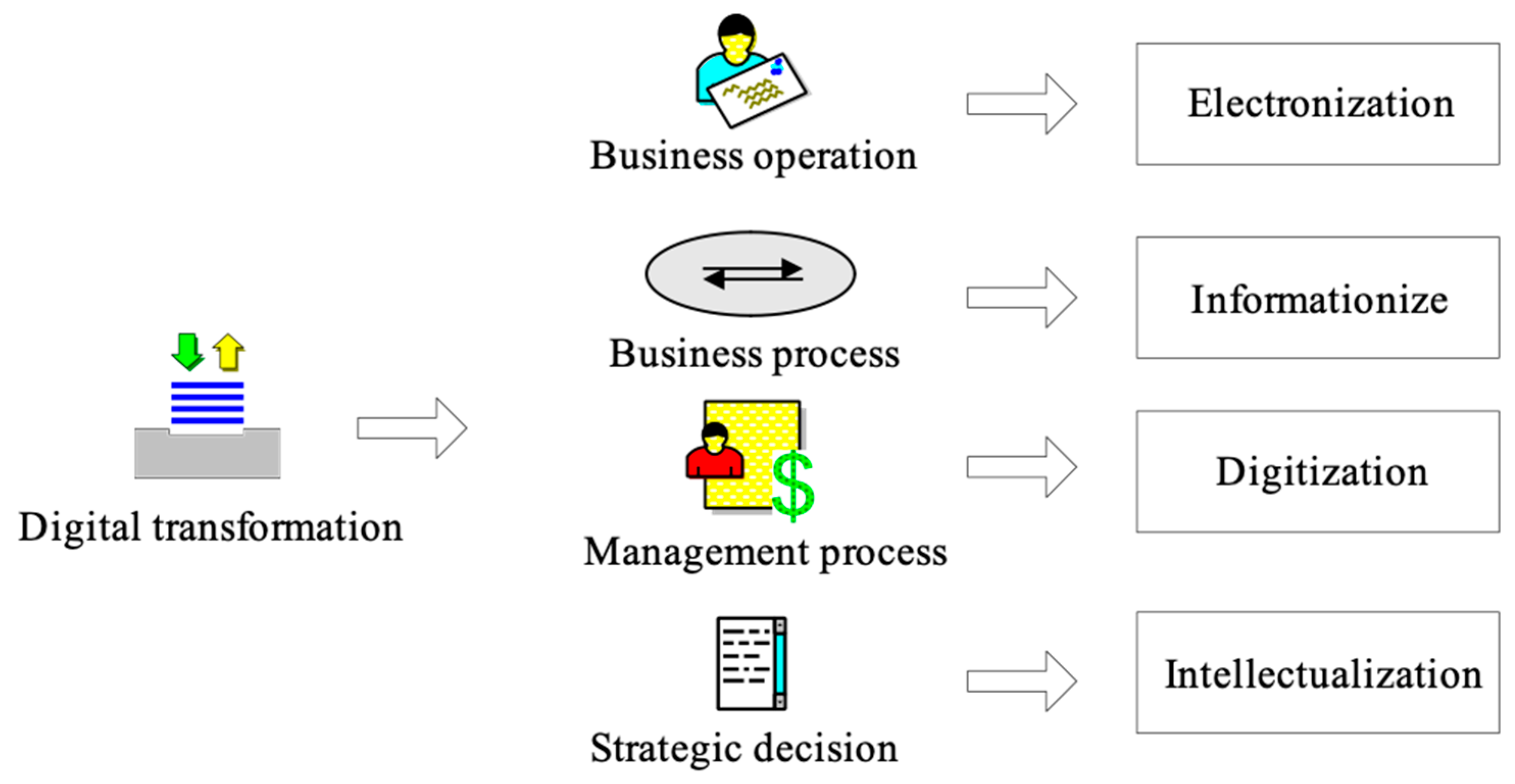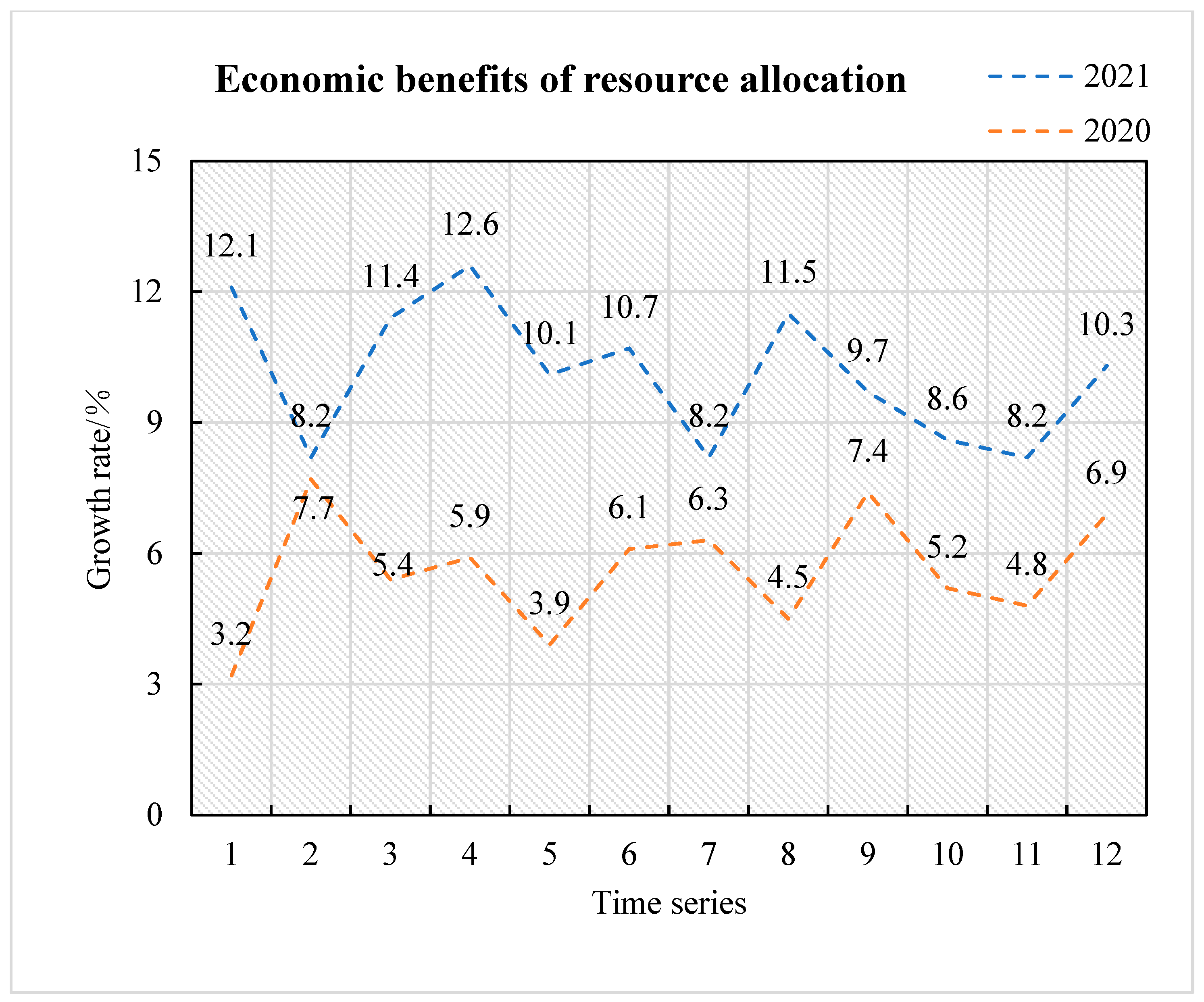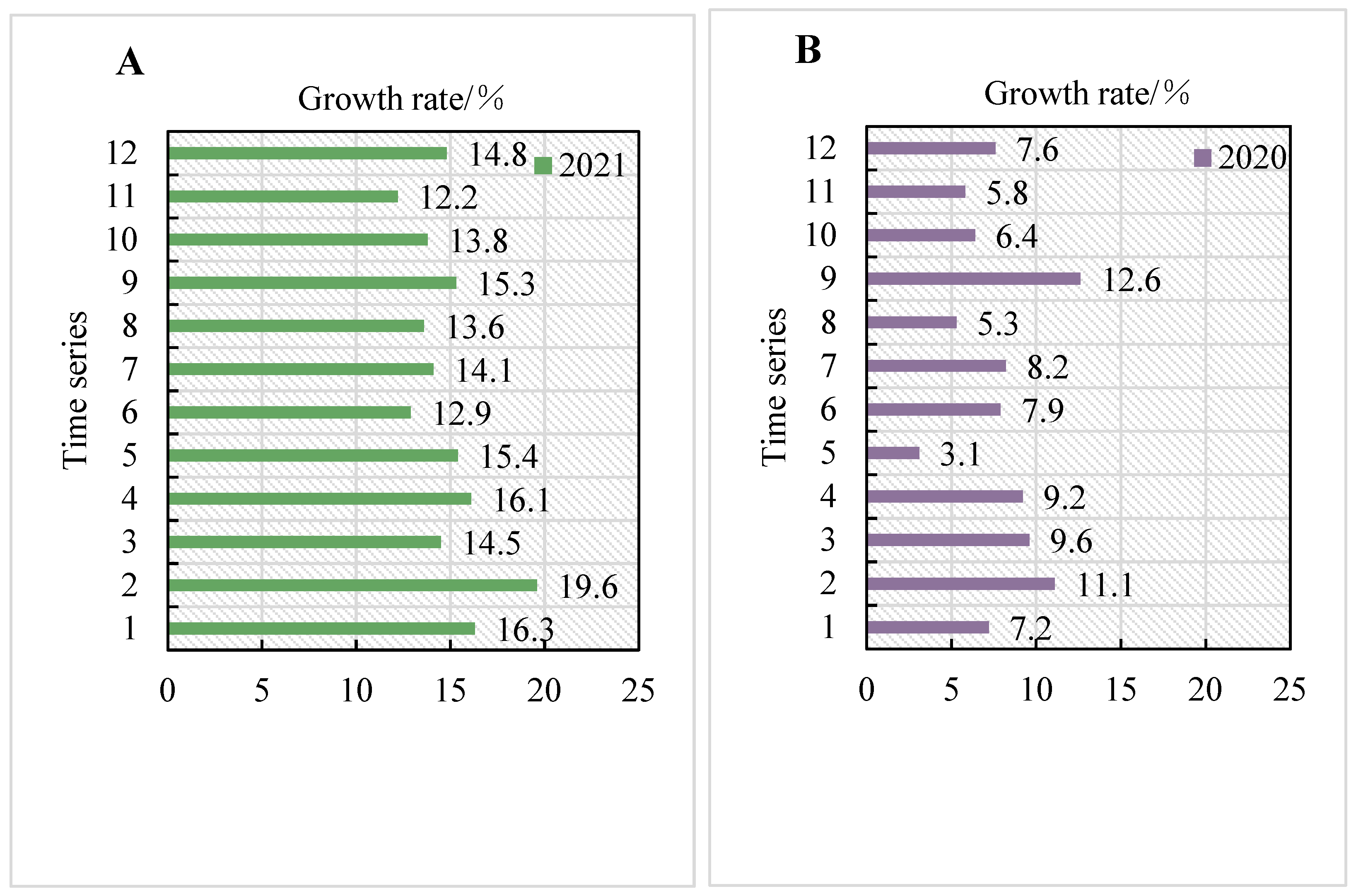1. Introduction
With the development of social economy and environmental science theory, the carbon emissions of enterprises and their impact on environmental sustainability have been increasingly valued by all sectors. While creating social wealth, enterprises have also brought a large amount of resource consumption, which leads to great challenges for environmentally sustainable development. As an important direction of the development of digital economy, digital transformation can provide enterprises with comprehensive and high-quality digital services, so that enterprises can improve customer experience while realizing commercial and social values. It can also reduce resource consumption, thus creating more benefits. However, digital transformation refers to the comprehensive transformation of enterprises across all businesses and functions. At present, enterprises lack technical and theoretical support, and most of the digital deployment is still in the pilot stage, which has seriously hindered the continuous investment in digital transformation. With the mature development of computer science and philosophy, the Metaverse theory has made great progress and has been widely used in various fields [
1]. The Metaverse can effectively promote the practical value and significance of digital transformation, and can provide a strong guarantee for carbon neutrality and green sustainable development [
2,
3].
This paper conducts an in-depth study of digital transformation from the perspective of the metauniverse to help carbon neutrality and green sustainable development. This paper evaluates the effect of Digital transformation from the perspective of enterprise economic benefit and environmental benefit growth. From the analysis results, it can be seen that from the perspective of the metauniverse, digital transformation not only promotes the growth of an enterprise’s economic benefits to a certain extent, but also makes progress in an enterprise’s environmental benefits, which has produced a relatively ideal effect on carbon neutrality and green sustainable development.
2. Digital Transformation Promotes Carbon Neutrality and Green Sustainable Development
2.1. Literature Review
In the information age, the role and impact of digital transformation in carbon neutrality and green sustainable development are increasingly attracting the attention of scholars. Elgohary, Esam believed that digital transformation was gradually changing governments and enterprises, making them more competitive, and providing several opportunities for economic growth and prosperity. He reviewed the 17 Sustainable Development Goals (SDG) and explained the impact of digital information technology. He then showed the relevant work and achievements of the Egyptian government in using information and communication technology to achieve sustainable development [
4]. Ufua, Daniel E explored the potential of digital transformation to achieve the sustainable development goals of the United Nations. He adopted a conceptual approach to review the existing literature and discussed the issue from different perspectives. The results showed that digital transformation might promote the realization of SDG in education, industry, and other fields [
5]. Nayal, Kirti used a structural equation model (SEM) to analyze the data of 361 respondents in the Indian automobile industry. The research results showed that only in the process of digital transformation can enterprises improve their development advantages and realize their SDG [
6]. Shen, Lei believed that in the new manufacturing sector, the textile industry was facing opportunities and challenges brought by the sustainable development model and advanced manufacturing technology. He used the data of 367 questionnaires of textile enterprises and multiple regression analysis to test the impact of digital technology on enterprise development. The results showed that digital innovation orientation had a positive regulatory effect on the realization of enterprise SDG [
7]. The analysis of digital transformation to help carbon neutrality and green sustainable development has achieved good results, but most of the research is not based on the actual development of the information age.
With the development of Metaverse and other intelligent technologies, the research perspective of digital transformation to help carbon neutrality and green sustainable development has been expanded and popularized. Renn, Ortwin believed that digital transformation can promote the realization of social and industrial SDG. However, many opportunities were closely related to risks. He studied the sustainability of industry review and classification from the perspective of system risk and income, and analyzed the main impact of digital transformation on ecological, economic, and social aspects [
8]. Zienarski, Piotr used descriptive methods and literature analysis methods to study whether digital transformation has played a positive role in the sustainable development of tourism. The results showed that the sustainable development of all industries, including tourism, was not only a new social trend, but also a necessary condition for the survival of a new generation [
9]. The existing research analyzed the value of enterprise digital transformation from different perspectives. However, the existing research mainly focused on the theoretical level of the Metaverse, and did not study its practical value.
2.2. Carbon Neutrality and Green Sustainable Development
2.2.1. Carbon Neutrality
The meaning of carbon neutrality must be understood in practice and theory. According to the view of human social development, in order to maintain the stability of the ecological environment, the carbon emissions in human production and life must be within the acceptable range of the earth environment. In fact, the total amount of pollution emitted by human beings in production and life has far exceeded the ecological balance of the earth, and the amount of carbon emissions has far exceeded the acceptable limit of the environment, which has led to the intensification of the greenhouse effect and caused great damage to the ecological environment. Human activities should be carried out within the acceptable range of the ecological environment, and the ultimate goal of carbon neutralization is to limit the carbon emissions in human production and life to the range that the ecosystem can purify. To achieve the goal of carbon neutrality, people would first experience the peak of total social carbon emissions. With the implementation of the control plan, the total social carbon emissions would gradually decline from the peak until reaching the carbon neutral standard, as shown in
Figure 1.
Carbon emission enterprises undertake huge tasks and responsibilities in environmental protection, and also play a crucial role in achieving the goal of carbon neutrality. The implementation of green, low-carbon and innovative techniques is the inevitable choice for the sustainable development of enterprises at present, and also the only way for enterprises to enhance their value [
10].
2.2.2. Green and Sustainable Development
The concept of green sustainable development originated from ecological theory, which is a management strategy for resources, and has been widely used in economic and social development [
11]. As a comprehensive theory, it mainly includes economic, social, cultural, technological, and natural environment development theories [
12], as shown in
Figure 2. Green sustainable development is the reflection of human beings on their own development and natural environment [
13]. It is not only a question and rejection of the past development path, but also a desire for the future development direction and goals.
At present, green sustainable development has become an important goal and guideline for many famous enterprises at the forefront of strategic management to follow when formulating their future development strategies [
14]. It is mainly reflected in two aspects:
First, due to the limited number of resources, the sustainable development model of enterprises and how to effectively develop the limited resources have become important issues facing enterprises [
15]. Second, from the perspective of enterprise product life cycles and sustainable development, enterprises can make their own development life cycle exceed the product life cycle through reasonable time arrangement, as shown in
Figure 3.
2.3. Metaverse and Digital Transformation
2.3.1. Overview of Metaverse
From the perspective of technology integration, the Metaverse is a process of combining various technologies to realize the integration of virtual and reality [
16], as shown in
Figure 4. In the process of rapid development of science and technology, different technology types and technology development purposes are different. There are also incompatibilities and difficulties in interaction between technology theories [
17]. The concept of Metaverse is to unify these technologies and make them integrate and interact with each other [
18,
19].
2.3.2. Digital Transformation
Before defining enterprise digital transformation, people need to understand enterprise transformation first. The basic content of enterprise transformation is shown in
Figure 5.
There are broad and narrow understanding of enterprise transformation. In a broad sense, the meaning of enterprise transformation is relatively general [
20]. The enterprise transformation behavior includes the enterprise’s operation direction transformation, system transformation and development strategy change [
21,
22]. When an enterprise is in a non-optimal state, competitive advantage is declining or growth is declining, it needs to consider enterprise transformation, as shown in
Figure 6.
In the Metaverse, the digital transformation of enterprises is a high-level transformation based on digital technology [
23,
24]. Specifically, an enterprise must comprehensively and systematically define and restructure its own management model, resource allocation process, business model, personnel quality, and other aspects, as shown in
Figure 7. When carrying out digital transformation, enterprises should not only focus on the innovation and application of their own digital technology, but also break through the traditional boundaries, so that enterprises can better integrate into the industrial development with the inclusiveness of the network, and then carry out good competition and cooperation [
25].
To systematically, scientifically, and comprehensively discuss the digital transformation of enterprises, people must classify the various stages of digital transformation [
26]. Based on the history and development trend of the metauniverse, digital transformation can be divided into four stages [
27,
28], as shown in
Figure 8:
The first stage is the electronic operation of business. The main content of this stage is to make use of the power of mechanical and electronic equipment to enable employees to get rid of tedious and repetitive work and improve the production efficiency of enterprises [
29]. This stage is characterized by the single use of computer and other electronic equipment in some aspects, as shown in
Table 1:
The second stage is the informatization of business process. Informatization means that enterprises use their own information technology advantages to realize the systematization of their business processes.
The third stage is the digitalization of the management process. The focus of this stage is to use digital technology to effectively integrate the upstream and downstream resources of enterprises and break through information barriers. It fully coordinates all aspects of work, eliminates “information islands”, and links all business processes together to form a “chain” structure, as shown in
Figure 9.
The fourth stage is the wisdom of strategic decision-making. At this stage, the company can combine existing knowledge with advanced AI technology to conduct in-depth mining and data analysis of market information [
30]. With the continuous development of Internet technology, the digital transformation in the perspective of the Metaverse provides a fast and convenient way for enterprises to obtain environmental information [
31,
32]. At the same time, it also lays the foundation for information exchange between enterprises and data collection and management within enterprises. This is crucial to the realization of carbon neutrality and green SDG of enterprises.
3. Research Methods
Under the metauniverse model, this paper took digital transformation as technical support to build a development model to help realize carbon neutrality and green SDG. Prior to this, this study established an evaluation index system for carbon-neutral and green sustainable development, assisted by enterprise digital transformation based on the metauniverse theory, in combination with the development of enterprises under digital transformation, and with relevant factors that affect their achievement of carbon neutral and green sustainable development goals, as shown in
Table 2.
From
Table 2, the carbon-neutral and green sustainable development goals and evaluation indicators are economic benefit indicators and environmental benefit indicators. Economic efficiency is the basic prerequisite for achieving the goals of carbon neutrality and green sustainable development, mainly including resource allocation and technological progress. These indicators affect the material foundation of the enterprise, and only with a material foundation can the sustainable development of the enterprise be achieved. Environmental benefits are a powerful guarantee for carbon neutrality and green sustainable development goals, mainly including carbon emission levels and carbon emission reduction efficiency. Per capita carbon emissions, carbon emission intensity, carbon emission growth rate, and decoupling index are important factors affecting emission levels and emission reduction efficiency.
The evaluation indicators for enterprise digital transformation mainly include the strategic effectiveness and effectiveness of the enterprise, as well as the operating level and ability of the enterprise. Among them, comprehensive income rate and asset turnover rate can reflect the utility and benefits of enterprise strategy in practical application, while the utilization rate of digital equipment in operation and management processes and the completion rate of data analysis can reflect the operating level and ability of enterprises.
In the development model, enterprises can continuously adjust their development strategies by analyzing and evaluating different development data in the evaluation system.
First, people need to determine the development data matrix, which is expressed as:
Let
be the second indicator of the
development data in the data matrix. Based on the enterprise’s digital transformation strategy, the proportion of different indicators in the sample in specific indicators can be calculated. If there is no negative value in the data, it is not necessary to perform non-negative operation on it. Then people can calculate the proportion of
in the data matrix
, which is expressed as:
The energy value of the
index is calculated as follows:
In Formula (3),
and
are related to the amount of enterprise development data, so:
Among them, .
For the
indicator, the greater the difference of the indicator value of
, the greater the thrust and energy value of carbon neutrality and green SDG, among them:
The higher the
value is, the more important the
index is. The weight calculation formula is:
With the development model under digital transformation as a reference, enterprises can fully understand the local policy support and environmental development information based on their actual development. People can continuously improve business levels in exploring the path of carbon neutrality and green SDG.
4. Demonstration of Digital Transformation Promoting Carbon Neutrality and Green Sustainable Development
In order to verify the effectiveness of digital transformation in helping carbon neutral and green sustainable development, based on the perspective of the Metaverse, this paper took a medium-sized enterprise as the research object and made an empirical analysis of its development results in the process of digital transformation. The enterprise would focus on traditional manufacturing before 2019. Influenced by intelligent technology, the enterprise began to try digital transformation in 2019 and focused on intelligent manufacturing. The basic information of the enterprise is shown in
Table 3. This paper establishes a sample set based on the development data of enterprises before 2021, and calculates the proportion of different indicators in specific indicators in the sample, through the development matrix based on the carbon neutrality green sustainable development goal evaluation system in
Table 2. Finally, the development model based on the metauniverse perspective is applied to the company’s digital transformation development strategy in 2021, and the implementation effects of carbon neutrality and green SDG are evaluated from the perspective of the company’s economic and environmental benefits growth and digital transformation effects. In order to ensure the contrast of the experimental results, this paper compared the empirical results in 2021 with the development results under the application of traditional strategies in 2020 (without considering the changes in market economy and technological development caused by time factors).
- (1)
Digital Transformation
This article compares the effectiveness and benefits of the company’s development strategy in 2020 and 2021, as well as its operational level and capacity. It evaluates the company’s comprehensive income rate, asset turnover rate, utilization rate of digital equipment in operation management processes, and data analysis completion rate in two years. The specific results are shown in
Table 4:
As can be seen in
Table 4, compared to 2020, under the digital transformation development strategy based on the metauniverse perspective, the company’s comprehensive income and asset turnover have improved, and the utilization of digital equipment and data analysis efficiency have also improved. From this point of view, the digital transformation effect of the enterprise in the perspective of the metauniverse is good.
- (2)
Economic benefit growth
Economic benefits are the material basis for maintaining the sustainable development of enterprises. It mainly includes the economic benefits of resource allocation and technological progress. The former refers to the benefits generated by changes in the resource allocation structure in the development process of enterprises. The latter refers to the benefits generated by the improvement of enterprise production technology. In the process of digitalization, the effective allocation of enterprise resources and the transformation and improvement of production technology can effectively promote the realization of carbon neutrality and green SDG. This paper made statistics on the economic benefits of resource allocation and technological progress of the enterprise in 2020 and 2021, and the results were shown in
Figure 10 and
Figure 11:
From the specific growth in
Figure 10, it can be seen that the economic benefit growth of the enterprise’s resource allocation in 2021 is significantly better than that in 2020. In the process of digitalization from the perspective of the metauniverse, the economic efficiency growth rate of resource allocation of enterprises will reach over 8% every month in 2021; Under the digitization process of traditional development strategies, the economic efficiency growth rate of resource allocation for enterprises in 2020 has not reached 8% per month, with the highest growth rate reaching only 7.7%. From the specific numerical results, in the perspective of the metauniverse, the economic benefits of resource allocation of the enterprise achieved a certain improvement in 2021. This is mainly due to the introduction of digital technology in capital investment, production material allocation, and intangible asset allocation, and the implementation of resource allocation plans through scientific data analysis, as well as the implementation of plan decisions through systematic business processes.
The enterprise has shifted from traditional manufacturing to intelligent manufacturing since 2019. Therefore, the progress of production technology was particularly important for the growth of the overall economic benefits of the enterprise. From
Figure 11, compared with 2020, the economic benefits of the enterprise’s technological progress in 2021 were more obvious. In
Figure 11A, the economic benefit growth rate of the enterprise’s technological progress in each month in 2021 has reached over 10%; In
Figure 11B, the maximum economic benefit growth rate of the company’s technological progress per month in 2020 is only 7.6%. From the perspective of specific economic growth, the growth of its technological progress and economic benefits is mainly reflected in the improvement of its product sales revenue and market share. Taking knitted textiles, textile fabrics, and clothing accessories as examples, its product sales revenue and market share are shown in
Table 5. From the perspective of the metauniverse, the company has effectively integrated digital technology through digital transformation, resulting in a certain improvement in the overall economic benefits brought by technology in 2021 compared to last year.
- (3)
Environmental benefit growth
Environmental benefits refer to the corresponding changes in the structure and function of the ecosystem caused by pollution discharge or environmental management on the basis of the occupation and consumption of certain resources in the production activities of enterprises. This can have an impact on human life and production environment. This paper made statistics on the growth and changes of the environmental and economic benefits of the enterprise in 2020 and 2021, and the results were shown in
Figure 12:
In
Figure 12A, the environmental benefit growth rate of the enterprise in each month in 2021 reached over 12%, with the highest growth rate reaching 19.6%; In
Figure 12B, the highest growth rate of environmental benefits for the enterprise in 2020 reached 12.6%. From the comparison results of environmental benefits over two years, the digital transformation based on the perspective of the Metaverse has a more significant impact on the carbon neutrality and green sustainable development of enterprises. From the perspective of the metauniverse, combined with the development matrix, the enterprise has continuously adjusted its pollution emission measures, and its total energy consumption has decreased. The application of digital technology has enabled the enterprise to achieve certain results in energy conservation and emission reduction, resulting in a certain increase in the overall environmental benefits of the enterprise in 2021.
5. Discussion
Overall, the empirical analysis results of this article are shown in
Table 6:
With the development of information technology, digital technology has achieved significant progress, which is valuable in promoting the optimization of enterprise production and operation, and promoting the realization of carbon neutral and green, sustainable development goals. However, with the widespread implementation of digital technology, its limitations continue to emerge. Digital technology is dependent on data, and the security protection of enterprise development data needs to be further strengthened. In addition, the limitations of digital technology application scenarios have created a digital divide in different enterprise applications. For larger enterprises, their digital technology is often more advanced, but the digital risks they face will also increase accordingly; For small and medium-sized enterprises, digital technology is often relatively backward, and their digital risks will be smaller. However, in terms of resource demand and environmental impact, the economic and environmental benefits brought about by digital transformation can effectively promote the rational allocation of enterprise resources, promote the expansion of enterprise operations, and achieve more long-term development in the market.
6. Conclusions
The enterprise production process is the process of continuous transformation of available resources. In this process, a large number of resources would be consumed and waste resources would be generated, which has seriously hindered the sustainable development of society. The digital transformation of enterprises can effectively improve the production and management level of enterprises and reduce the burden and negative impact of enterprises on the environment. In order to enhance the contribution of digital transformation to carbon neutrality and green sustainable development, this paper has conducted in-depth research on it in light of the Metaverse. This can not only improve the resource allocation and technical levels to a certain extent, but also improve the environmental benefits of enterprises and promote the realization of carbon neutrality and green SDG. Although this study has certain relevance for the sustainable development of enterprises, the research process still needs to be improved. In future research, it would continue to improve these limitations and problems, improve the quality and level of research, and provide more scientific reference for the realization of carbon neutrality and green SDG.
Author Contributions
Methodology, W.C.; Software, W.C. and Z.C.; Formal analysis, Z.C., X.Y. and L.C.; Data curation, X.Y.; Writing—original draft, W.C., Z.C. and X.Y.; Writing—review & editing, W.C. and L.C. All authors have read and agreed to the published version of the manuscript.
Funding
This work is supported by Scientific Research Foundation of Hangzhou City University (J202310).
Institutional Review Board Statement
Not applicable.
Informed Consent Statement
Not applicable.
Data Availability Statement
The data that support the findings of this study are available from the corresponding author upon reasonable request.
Conflicts of Interest
The authors declare no conflict of interest.
References
- Panagiotakopoulos, D.; Marentakis, G.; Metzitakos, R.; Deliyannis, I.; Dedes, F. Digital scent technology: Toward the internet of senses and the metaverse. IT Prof. 2022, 24, 52–59. [Google Scholar] [CrossRef]
- Aburbeian, A.H.M.; Owda, A.Y.; Owda, M. A technology acceptance model survey of the metaverse prospects. AI 2022, 3, 285–302. [Google Scholar] [CrossRef]
- Alanah, D.; John, M.; Dawn, O.; Deepak, K.; Ilze, Z. Avatars, people and virtual worlds: Foundations for research in metaverses. J. Assoc. Inf. Syst. 2009, 2, 90–117. [Google Scholar]
- Elgohary, E. The Role of Digital Transformation in Sustainable Development in Egypt. Int. J. Inform. Media Commun. Technol. 2022, 4, 71–106. [Google Scholar] [CrossRef]
- Ufua, D.E.; Emielu, E.T.; Olujobi, O.J.; Lakhani, F.; Borishade, T.T.; Ibidunni, A.S.; Osabuohien, E.S. Digital transformation: A conceptual framing for attaining Sustainable Development Goals 4 and 9 in Nigeria. J. Manag. Organ. 2021, 27, 836–849. [Google Scholar] [CrossRef]
- Nayal, K.; Raut, R.D.; Yadav, V.S.; Priyadarshinee, P.; Narkhede, B.E. The impact of sustainable development strategy on sustainable supply chain firm performance in the digital transformation era. Bus. Strat. Environ. 2021, 31, 845–859. [Google Scholar] [CrossRef]
- Shen, L.; Zhang, X.; Liu, H. Digital technology adoption, digital dynamic capability, and digital transformation performance of textile industry: Moderating role of digital innovation orientation. Manag. Decis. Econ. 2021, 43, 2038–2054. [Google Scholar] [CrossRef]
- Renn, O.; Beier, G.; Schweizer, P.-J. The opportunities and risks of digitalisation for sustainable development: A systemic perspective. GAIA—Ecol. Perspect. Sci. Soc. 2021, 30, 23–28. [Google Scholar] [CrossRef]
- Piotr, Z.; Malgorzata, S.-P. Sustainable Tourism Development in The Era of Digital Transformation. OPUS Int. J. Soc. Res. 2019, 10, 2157–2167. [Google Scholar]
- Ghobakhloo, M.; Iranmanesh, M.; Grybauskas, A.; Vilkas, M.; Petraitė, M. Industry 4.0, innovation, and sustainable development: A systematic review and a roadmap to sustainable innovation. Bus. Strat. Environ. 2021, 30, 4237–4257. [Google Scholar] [CrossRef]
- Sachs, J.D.; Schmidt-Traub, G.; Mazzucato, M.; Messner, D.; Nakicenovic, N.; Rockström, J. Six Transformations to achieve the Sustainable Development Goals. Nat. Sustain. 2019, 2, 805–814. [Google Scholar] [CrossRef]
- Xu, S. Interaction between Digital Economy and Environmental Pollution: New Evidence from a Spatial Perspective. Int. J. Environ. Res. Public Health 2022, 19, 5074. [Google Scholar] [CrossRef] [PubMed]
- Gómez-González, S.; Ochoa-Hueso, R.; Pausas, J.G. Afforestation Falls Short as a Biodiversity Strategy. Science 2020, 368, 1438–1439. [Google Scholar] [CrossRef]
- Nguyen Hoang, T. Natural resources limitation and the impact on sustainable development of enterprises. Int. J. Res. Financ. Manag. 2019, 3, 80–84. [Google Scholar]
- Álvarez Jaramillo, J.; Zartha Sossa, J.W.; Orozco Mendoza, G.L. Barriers to sustainability for small and medium enterprises in the framework of sustainable development—L iterature review. Bus. Strategy Environ. 2019, 28, 512–524. [Google Scholar] [CrossRef]
- Stylianos, M. Metaverse. Encyclopedia 2022, 2, 486–497. [Google Scholar]
- Bibri, S.E. The Social Shaping of the Metaverse as an Alternative to the Imaginaries of Data-Driven Smart Cities: A Study in Science, Technology, and Society. Smart Cities 2022, 5, 832–874. [Google Scholar] [CrossRef]
- Wang, F.-Y.; Qin, R.; Wang, X.; Hu, B. MetaSocieties in Metaverse: MetaEconomics and MetaManagement for MetaEnterprises and MetaCities. IEEE Trans. Comput. Soc. Syst. 2022, 9, 2–7. [Google Scholar] [CrossRef]
- Florian, B.; Oppermann, L.; Prinz, W. There’s more than one metaverse. i-com 2022, 21, 313–324. [Google Scholar]
- Berry, L.L.; Bolton, R.N.; Bridges, C.H.; Meyer, J.; Parasuraman, A.; Seiders, K. Opportunities for Innovation in the Delivery of Retail Interactive Services. J. Interact. Mark. 2010, 2, 155–167. [Google Scholar] [CrossRef]
- Chung, N.; Han, H.; Joun, Y. Tourists’ intention to visit a destination: The role of augmented reality (AR) application for a heritage site. Comput. Hum. Behav. 2015, 50, 588–599. [Google Scholar] [CrossRef]
- Grubert, J.; Ofek, E.; Pahud, M. The Office of the Future: Virtual, Portable, and Global. IEEE Comput. Graph. Appl. 2018, 6, 125–133. [Google Scholar] [CrossRef] [PubMed]
- Park, S.M.; Kim, Y.G. A Metaverse: Taxonomy, Components, Applications, and Open Challenges. IEEE Access 2022, 10, 4209–4251. [Google Scholar] [CrossRef]
- Varadarajan, R.; Srinivasan, R.; Vadakkepatt, G.G.; Yadav, M.S.; Pavlou, P.A.; Krishnamurthy, S.; Krause, T. Interactive Technologies and Retailing Strategy: A Review, Conceptual Framework and Future Research Directions. J. Interact. Mark. 2010, 24, 96–110. [Google Scholar] [CrossRef]
- Du, X.; Jiang, K. Promoting enterprise productivity: The role of digital transformation. Borsa Istanb. Rev. 2022, 22, 1165–1181. [Google Scholar] [CrossRef]
- Loonam, J.; Eaves, S.; Kumar, V.; Parry, G. Towards digital transformation: Lessons learned from traditional organizations. Strat. Chang. 2018, 27, 101–109. [Google Scholar] [CrossRef]
- Fettweis, G.P. The tactile internet: Applications and challenges. IEEE Veh. Technol. Mag. 2014, 9, 64–70. [Google Scholar] [CrossRef]
- Ball, M. The Metaverse: What It Is, Where to Find it, and Who Will Build It. Available online: https://www.matthewball.vc/all/themeta-verse.2020 (accessed on 3 April 2020).
- MacInnis, D.J.; Jaworski, B.J. Information processing from advertisements: Toward an integrative framework. J. Mark. 1989, 53, 1–23. [Google Scholar] [CrossRef]
- Ogrean, C.; Herciu, M. Digital Transformation as Strategic Shift—A Bibliometric Analysis. Stud. Bus. Econ. 2021, 16, 136–151. [Google Scholar] [CrossRef]
- Huggett, J. Virtually real or really virtual: Towards a heritage Metaverse. Stud. Digit. Herit. 2020, 1, 1–15. [Google Scholar] [CrossRef]
- Jin, H. Licensing Effect of Pro-enviromental Behavior in Metaverse. Cyberpsychol. Behav. Soc. Netw. 2022, 25, 709. [Google Scholar] [CrossRef] [PubMed]
| Disclaimer/Publisher’s Note: The statements, opinions and data contained in all publications are solely those of the individual author(s) and contributor(s) and not of MDPI and/or the editor(s). MDPI and/or the editor(s) disclaim responsibility for any injury to people or property resulting from any ideas, methods, instructions or products referred to in the content. |
© 2023 by the authors. Licensee MDPI, Basel, Switzerland. This article is an open access article distributed under the terms and conditions of the Creative Commons Attribution (CC BY) license (https://creativecommons.org/licenses/by/4.0/).
